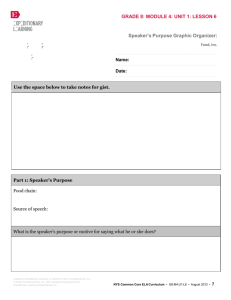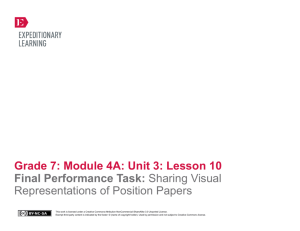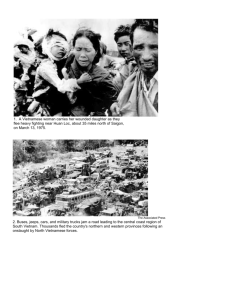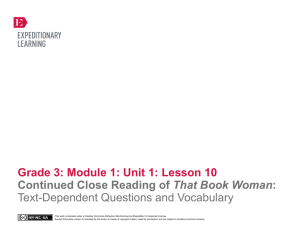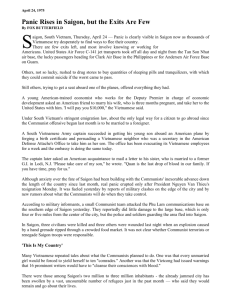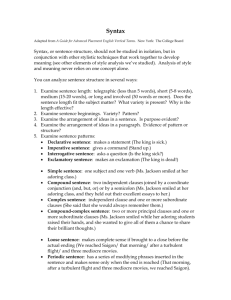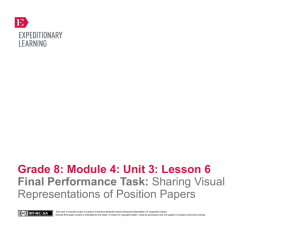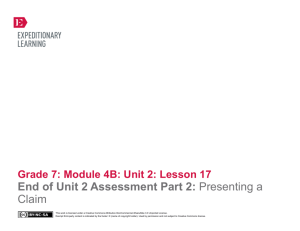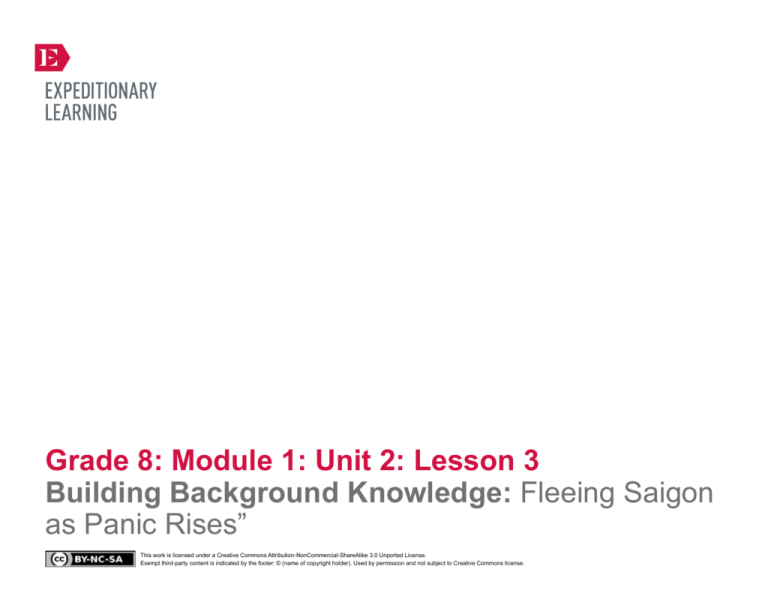
Grade 8: Module 1: Unit 2: Lesson 3
Building Background Knowledge: Fleeing Saigon
as Panic Rises”
This work is licensed under a Creative Commons Attribution-NonCommercial-ShareAlike 3.0 Unported License.
Exempt third-party content is indicated by the footer: © (name of copyright holder). Used by permission and not subject to Creative Commons license.
GRADE 8: MODULE 1: UNIT 2: LESSON 3
Building Background Knowledge:
Fleeing Saigon as “Panic Rises”
Long-Term Targets Addressed (Based on NYSP12 ELA CCLS)
I can cite text-based evidence that provides the strongest support for an analysis of informational text. (RI.8.1)
I can determine a theme or the central ideas of an informational text. (RI.8.2)
I can analyze the connections and distinctions between individuals, ideas, or events in a text. (RI.8.3)
I can use a variety of strategies to determine the meaning of unknown words or phrases. (L.8.4)
Supporting Learning Targets
Ongoing Assessment
• I can identify the strongest evidence in the text “Panic Rises in Saigon, but the Exits Are Few” that helps
me explain what challenges refugees from South Vietnam faced.
• Structured notes (for pages 91–111, from homework)
• I can use common Greek and Latin affixes (prefixes) and roots as clues to help me know what a word
means.
• I can identify common themes that connect the universal refugee experience.
Created by Expeditionary Learning, on behalf of Public Consulting Group, Inc.
© Public Consulting Group, Inc., with a perpetual license granted to Expeditionary Learning Outward Bound, Inc.
• Fleeing Home: What Challenges Did Ha’s Family Face?
graphic organizer
• Answers to text-dependent questions
• Prefixes note-catcher
NYS Common Core ELA Curriculum • G8:M1:U2:L3 • June 2014 •
1
GRADE 8: MODULE 1: UNIT 2: LESSON 3
Building Background Knowledge:
Fleeing Saigon as “Panic Rises”
Agenda
Teaching Notes
1. Opening
• Lessons 3–6 focus on informational texts that help students to explore the refugee experience in preparation
for the mid-unit assessment. Students are at a logical point in the novel (as Ha travels to America) to read
informational texts to build more knowledge about the world—specifically to broaden their understanding of
common refugee experiences.
A. Engaging the Reader: What Challenges Did
Ha’s Family Face? (10 minutes)
B. Review Learning Targets (2 minutes)
2. Work Time
A. Teacher Read-aloud: “Panic Rises in Saigon,
but the Exits Are Few” (5 minutes)
B. Answering Text-Dependent Questions for
“Panic Rises in Saigon, but the Exits Are Few”
(15 minutes)
C. Guided Practice: Vocabulary to Deepen
Understanding (10 minutes)
3. Closing and Assessment
A. Debrief Learning Targets and Preview
Homework (3 minutes)
4. Homework
A. Finish your answers to the text-dependent
questions if you did not do so in class.
B. Complete a first read of pages 115–134. Take
notes (in your journal) using the Structured
Notes graphic organizer.
• Though Lessons 3–6 emphasize informational texts, students continue to read the novel for homework.
• The opening activity each day will allow for group discussion, including a focus on key vocabulary or critical
passages that help reveal aspects of the challenges Ha faces (i.e., the conflict in the novel) and Ha’s character
as a sort of case study of the more universal refugee experience.
• Students will discuss how Ha’s life is being turned “inside out.” This will help them understand the meaning of
the novel’s title, which students write about as part of their end of unit essay. The focus of students’ structured
notes (for homework) changes as they begin to find evidence of how Ha’s life is being turned “inside out.”
• Do not define the phrase “inside out” for students. Let them gradually come to an understanding of this phrase
across Lessons 3–6 as they read, think, talk, and write about some common themes in the universal experience
of refugees all over the world.
• In this lesson, students return to the informational text from Unit 1, Lesson 1: “Panic Rises in Saigon, but the
Exits Are Few.” In Unit 1, they read selected quotes from the full text to build some basic background
knowledge and pique their interest about the topic of the module. Now, they read the entire text to deepen
their understanding of the challenges faced by Vietnamese refugees as Saigon fell.
• Emphasize for students the interplay between the novel and the informational texts (this interplay relates
directly to CCSS Shifts 1 and 2). Help them notice how, across the module, their understanding of a topic is
growing. Students should be noticing the value of rereading a text once one knows more about a topic.
Throughout Unit 1 (by reading both the novel and informational texts), students built a great deal of
background knowledge about the fall of Saigon. They now can use this knowledge to analyze the article more
fully and make richer connections back to the novel.
• In Part B of the Opening, students are asked to think about the relationship between informational text and
historical fiction, which was emphasized throughout Unit 1. Review Unit 1, Lesson 6 in advance to determine
what connections to make for students here.
Created by Expeditionary Learning, on behalf of Public Consulting Group, Inc.
© Public Consulting Group, Inc., with a perpetual license granted to Expeditionary Learning Outward Bound, Inc.
NYS Common Core ELA Curriculum • G8:M1:U2:L3 • June 2014 •
2
GRADE 8: MODULE 1: UNIT 2: LESSON 3
Building Background Knowledge:
Fleeing Saigon as “Panic Rises”
Agenda
Teaching Notes (continued)
• In advance: Create the model graphic organizer Fleeing Home: What Challenges Did Ha’s Family Face?” (see
model in supporting materials) on your interactive white board, chart paper, or document camera. This should
look like the graphic organizer that students will complete.
• This lesson includes explicit instruction related to CCLS L.8.4. Emphasize with students the value of learning
prefixes, suffixes, and word roots/families as a powerful strategy to build their vocabulary as they read
increasingly complex texts.
• In this lesson, through embedded vocabulary instruction, students learn new prefixes (uni-, in-, and e-) and
two new roots: migrare (Latin for “to move from one place to another”) and vac (Latin for “to empty”). In
Lessons 3 and 4, students complete a note-catcher on some common prefixes from readings. Encourage
students to hold on to this Prefixes note-catcher, which they can continue to add to throughout the year. Some
future lessons in this unit continue to point students to prefixes they might add.
• Post: Learning targets.
Lesson Vocabulary
Materials
informational text, common themes, cause,
motivate/motivation; flee, inexorable,
stringent,
emigration/immigration/migrate/migration,
evacuees (n)/evacuate (v), totalitarian
• Inside Out & Back Again (book; one per student)
• Fleeing Home: What Challenges Did Ha’s Family Face? graphic organizer (one per student)
• Document camera
• “Panic Rises in Saigon, but the Exits Are Few” (one per student)
• Text-Dependent Questions for “Panic Rises in Saigon, but Exits Are Few” (one per student)
• Prefixes Note-catcher (one per student)
Created by Expeditionary Learning, on behalf of Public Consulting Group, Inc.
© Public Consulting Group, Inc., with a perpetual license granted to Expeditionary Learning Outward Bound, Inc.
NYS Common Core ELA Curriculum • G8:M1:U2:L3 • June 2014 •
3
GRADE 8: MODULE 1: UNIT 2: LESSON 3
Building Background Knowledge:
Fleeing Saigon as “Panic Rises”
Meeting Students’ Needs
Opening
A. Engaging the Reader: What Challenges Did Ha’s Family Face? (10 minutes)
• Students should be sitting with their small groups and should have their novel Inside Out & Back Again.
• Assign them to work with their odd or even partner (i.e., in each small group, numbers 1 and 3 work together; numbers 2
and 4 work together). Tell students that they are becoming increasingly independent with the novel. They will spend some
time each day sharing with each other about the novel. In the next few lessons, they also will have time to read informational
texts about other refugee experiences. This will help them put what they are learning about Ha in larger context.
• Ask students to think and then talk with a partner about the title of the novel, “Inside Out & Back Again.” Ask:
* “How is Ha’s life being turned ‘inside out’?”
• There is no need to clarify at this point: Tell students that they will keep thinking more about what “inside out” means over
the coming lessons.
• Be sure students have their text Inside Out & Back Again. Display and distribute the Fleeing Home: What Challenges Did
Ha’s Family Face? graphic organizer (on a document camera). Tell students that, to help them identify common themes
among refugee experiences, they will read several informational texts during the next few lessons and use graphic organizers
to take notes. Today, they will first think about the questions on this graphic organizer as they relate to Ha and her family,
based on evidence from the novel. Then they will complete a similar graphic organizer on Vietnamese refugees based on an
informational article. This investigation will give students a better understanding of Ha’s family’s motivation, or reason, for
leaving Vietnam.
• Read the graphic organizer prompt aloud. Ask:
* “What do you think the word flee means?”
• Give students a moment to think, then talk with a partner. Invite volunteers to respond. Listen for students to say “run
away” or “escape.” Point out that flee has the same root as “fly” and “flight.” Flee implies great haste; usually when people
flee, it is to escape immediate danger. Escape, by contrast, has a wider variety of meanings and often takes longer (like
escaping from prison or escaping from a boring job).
• Invite students to Think-Pair-Share with their odd or even partner in response to the graphic organizer prompt:
* “Which poems might have the strongest evidence to help you answer the question about the challenges they faced?”
• Give students a few minutes to go back into the text, skimming for which poems they think are most relevant.
Created by Expeditionary Learning, on behalf of Public Consulting Group, Inc.
© Public Consulting Group, Inc., with a perpetual license granted to Expeditionary Learning Outward Bound, Inc.
NYS Common Core ELA Curriculum • G8:M1:U2:L3 • June 2014 •
4
GRADE 8: MODULE 1: UNIT 2: LESSON 3
Building Background Knowledge:
Fleeing Saigon as “Panic Rises”
Meeting Students’ Needs
Opening (continued)
• Refocus students whole group. Probe and make a list on the board (with poem titles and page numbers) to be sure all
students have identified some poems that provide particularly strong evidence to answer the question about challenges they
faced (it’s great if students have identified other poems as well):
* “Choice” (page 55)
* “Wet and Crying” (page 60)
* “One Mat Each” (page 63)
* “Should We” (pages 44 and 45)
* “S-l-o-w-l-y” (page 75)
• Tell students that now that they have identified some poems, you would like them to choose just one or two to find some
specific evidence they think is particularly strong. Give partners a few minutes to work:
* “After the family flees Vietnam, what specific challenges does the family face?”
• Possible answers include not enough food on the ship, not enough water, going to the bathroom, ship troubles, living in a
tent city, etc.
• Then refocus students whole group and probe again:
* “In the poem ‘Should We,’ what does the family fear for Ha’s brothers?”
• Encourage students to think about the mental and emotional effect of a communist takeover—for example, the fear of
Brother Quang being brainwashed and Brother Khoi being interrogated to reveal private family conversations.
• Ask students:
* “Why might the communists want to probe family secrets?”
• Help them understand the nature of totalitarianism and the government’s desire to have a great deal of control over its
citizens. Reinforce with students that this novel is told from Ha’s perspective, so we are seeing the fears of communism
through her eyes.
• Model completing the graphic organizer, citing the strongest details from the text that show challenges the family faced as
they fled. Emphasize to students that since they are eighth-graders, it is not enough just to “cite evidence.” They should be
pushing themselves to select the best details to support their analysis of the text.
Created by Expeditionary Learning, on behalf of Public Consulting Group, Inc.
© Public Consulting Group, Inc., with a perpetual license granted to Expeditionary Learning Outward Bound, Inc.
NYS Common Core ELA Curriculum • G8:M1:U2:L3 • June 2014 •
5
GRADE 8: MODULE 1: UNIT 2: LESSON 3
Building Background Knowledge:
Fleeing Saigon as “Panic Rises”
Meeting Students’ Needs
Opening (continued)
• Share an example from a pair who are doing this well, or model as needed. A good example would be: “The refugees do not
have enough good food on the ship.” Text-based evidence comes from the poem “S-l-o-w-l-y”: “Hard and moldy, yet chewy
and sweet/inside./I chew each grain/slowly” (75).
• As time permits, repeat with one more detail and explanation. Another strong example is “having to leave things they love
behind, including the papaya tree.” Text-based evidence comes from the poem “Wet and Crying”: “Brother Vu chops;/the
head falls;/a silver blade slices./Black seeds spill like clusters of eyes, wet and crying” (60).
• Have students turn and talk to briefly discuss. Call a new voice to share his or her thinking.
B. Review Learning Targets (2 minutes)
• Have learning targets posted for review. Read aloud the first two learning targets:
* “I can identify the strongest evidence in the text ‘Panic Rises in Saigon, but the Exits Are Few’ that helps me explain what
challenges refugees from South Vietnam faced.”
* “I can use common Greek and Latin affixes (prefixes) and roots as clues to help me know what a word means.”
• Explain that today students will focus on informational text to help them better understand Ha’s experience leaving
Vietnam. Sometimes informational texts have vocabulary that readers have to figure out to build knowledge on the subject.
Emphasize that paying attention to the parts of words (prefixes, roots, and suffixes) is a powerful strategy for figuring out
unfamiliar words.
• Ask for student volunteers to explain the difference between informational text and fiction (historical fiction in particular).
Listen for mention of a purpose to inform, real events, objective, straightforward, and a “just the facts” perspective versus to
entertain, written from the perspective of a particular character, etc. Point out to students that they talked a lot about this
difference in Unit 1.
• Read the third learning target aloud:
* “I can identify common themes that connect the universal refugee experience.”
• Explain “common themes” to students—ideas or experiences that are universal. Ask:
* “Does anyone know what universal means?”
Created by Expeditionary Learning, on behalf of Public Consulting Group, Inc.
© Public Consulting Group, Inc., with a perpetual license granted to Expeditionary Learning Outward Bound, Inc.
NYS Common Core ELA Curriculum • G8:M1:U2:L3 • June 2014 •
6
GRADE 8: MODULE 1: UNIT 2: LESSON 3
Building Background Knowledge:
Fleeing Saigon as “Panic Rises”
Meeting Students’ Needs
Opening (continued)
• Call on volunteer(s) to help with the definition: “applies to everyone or all members of a group; general.” The prefix unicomes from the Latin unus and means “one” or “single.” Tell students that so far, the informational texts they’ve been
reading were meant specifically to build knowledge about Vietnam, but this is the first of several informational texts they will
be reading about the refugee experience.
Work Time
Meeting Students’ Needs
A. Teacher Read-aloud: “Panic Rises in Saigon, but the Exits Are Few” (5 minutes)
• Remind students of the quote strips they read during the first day of the module. (They used the quotes, along with the
Gallery Walk pictures, in Unit 1, Lesson 1 to try to predict what the unit was going to be about.) Tell them that they now get
to read the full article “Panic Rises in Saigon, but the Exits Are Few” by Fox Butterfield. Tell them that they will read
for two reasons: to connect the events of the article with the novel and to better understand the refugee experience.
• Hearing a complex text read slowly,
fluently, and without interruption or
explanation promotes fluency for
students. They are hearing a strong
reader read the text aloud with
accuracy and expression and are
simultaneously looking at and
thinking about the words on the
printed page. Be sure to set clear
expectations that students read
along silently as you read the text
aloud.
• Display the question:
* “What challenges did the South Vietnamese face?
• Tell students to follow along while you read aloud as a model of strong reading. Explain that students will have an
opportunity to read this on their own, too. Conduct a true read-aloud—read fluently, naturally, and with feeling, but do not
pause to explain or go over vocabulary.
Created by Expeditionary Learning, on behalf of Public Consulting Group, Inc.
© Public Consulting Group, Inc., with a perpetual license granted to Expeditionary Learning Outward Bound, Inc.
NYS Common Core ELA Curriculum • G8:M1:U2:L3 • June 2014 •
7
GRADE 8: MODULE 1: UNIT 2: LESSON 3
Building Background Knowledge:
Fleeing Saigon as “Panic Rises”
Work Time (continued)
Meeting Students’ Needs
B. Answering Text-Dependent Questions for “Panic Rises in Saigon, but the Exits Are Few”
(15 minutes)
• Pair students of mixed abilities together. Distribute the Text-Dependent Questions for “Panic Rises in Saigon, but
the Exits Are Few” handout. Explain that they should read through the article silently and then work with their partner to
annotate the text by underlining the evidence they find that helps them answer several questions.
• Mixed-ability grouping of students
for regular discussion and closereading exercises will provide a
collaborative and supportive
structure for reading complex.
Determine these groups ahead of
time.
• Direct students to look at the graphic organizer on the page and point out that it is very similar to the one they completed
about Ha. Ask students to silently read the next two questions before they begin rereading to look for evidence.
• As students are working, circulate and take note of students who have answered the questions with strong evidence from the
text(s). Listen and look for details such as: “The South Vietnamese couldn’t get visas to get out,” “The South Vietnamese
feared for their lives because three civilians had already been killed by a grenade in the food market,” and “They were afraid
of the advancing North Vietnamese.”
• Ask for a thumbs-up when groups are ready to share their answers. Invite a few students to share their responses to the
questions. Clarify as needed.
Note: As students read, post these words on the board: inexorable, stringent, emigration, evacuees.
Created by Expeditionary Learning, on behalf of Public Consulting Group, Inc.
© Public Consulting Group, Inc., with a perpetual license granted to Expeditionary Learning Outward Bound, Inc.
• Text-dependent questions can be
answered only by referring back to
the text being read. This encourages
students to reread the text for
further analysis and allows for a
deeper understanding.
• Some students may benefit from
having access to “hint cards”: small
slips of paper or index cards that
they turn over for hints about
how/where to find the answers to
text-dependent questions. For
example, a hint card might say:
“Check back in the third paragraph.”
NYS Common Core ELA Curriculum • G8:M1:U2:L3 • June 2014 •
8
GRADE 8: MODULE 1: UNIT 2: LESSON 3
Building Background Knowledge:
Fleeing Saigon as “Panic Rises”
Work Time (continued)
Meeting Students’ Needs
C. Guided Practice: Vocabulary to Deepen Understanding (10 minutes)
• Refocus students whole group. Distribute the Prefixes Note-catcher. Tell students you would like to focus on several
important words in the article that will help them think about what it was like for real people trying to leave Saigon, just like
Ha was. Explain that they will complete the note-catcher as the class discusses the words. The first prefix comes from the
word universal, which was discussed as part of the third learning target. Ask:
• Encourage students to use word
attack strategies: prefixes, root
words, suffixes, cognates, and
context.
* “Who remembers what the prefix uni- means?”
• Cold call a student to give the definition: single or one. Ask:
* “Who can give us a word that you know that starts with uni?”
• Invite students to share their ideas. Encourage students to write these word on the note-catcher. Expect them to mention
“universal,” but also possible answers such as “university,” “unique,” “uniform,” etc.
• Point students to the board and ask them to circle the four words in their text: inexorable, stringent, emigration, evacuees.
• Focus them on the word inexorable. Ask for a student volunteer to read the sentence. Ask:
* “After reading the sentence, what do you think the word inexorable means?”
• Give students a moment to think, then talk with a partner.
• To further support ELLs, consider
providing definitions of challenging
vocabulary in students’ home
language. Resources such as Google
Translate and bilingual translation
dictionaries can assist with oneword translation.
• ELLs may be unfamiliar with more
vocabulary words than are
mentioned in this lesson. Check for
comprehension of general words
that most students would know.
• Call on student volunteers, listening for answers such as “unstoppable.” Students may get close and say “inevitable.” Tell
them it means “impossible to stop or relentless.” Point out the prefix in-, which means “not.” Tell students to put the
meaning of the prefix on their note-catcher. Students may recognize that ex- has something to do with leaving, “out of,” or
“from.” Ask:
* “How does an “inexorable advance” of communists add to the feeling of panic?”
• Call on student volunteers, listening for answers such as: “They can’t stop the communists, so now they have to get out of the
country,” or “The communists can’t be stopped, so they have to flee.” Pause to give students time to write the meaning of the
word inexorable on their note-catcher.
• Next, focus students on the phrase stringent emigration laws. Ask:
* “Based on context clues, what you think stringent means?”
• Give students a moment to think, then talk with their partner.
• Call on a new voice in the room. Listen for “strict.” Give students that synonym if they cannot come up with it themselves.
Created by Expeditionary Learning, on behalf of Public Consulting Group, Inc.
© Public Consulting Group, Inc., with a perpetual license granted to Expeditionary Learning Outward Bound, Inc.
NYS Common Core ELA Curriculum • G8:M1:U2:L3 • June 2014 •
9
GRADE 8: MODULE 1: UNIT 2: LESSON 3
Building Background Knowledge:
Fleeing Saigon as “Panic Rises”
Work Time (continued)
Meeting Students’ Needs
• Next focus students on the word emigration. Ask:
• For students who struggle to read
complex texts, consider previewing
the following vocabulary words
from this text: inexorable, stringent,
emigration, immigration, migrate,
migration, and evacuees. If you
choose to select additional words to
preview, focus on words whose
meaning may be difficult to
determine using context clues from
the text. It is important for students
to practice using context clues to
determine word meaning so that
they become more proficient
readers.
* “How many of you actually read this as “stringent immigration laws”? Pause for show of hands.
• Ask:
* “What word can be found in the word emigration?”
• Cold call a student to answer. Listen for the response “migration” and guide students as needed. Say:
* “So what does migration or to migrate mean?”
• Cold call a student to answer “to move” or something similar. Ask:
* “So, what is the prefix added to that word?” If necessary, remind students that pre means before (like “pre-game
show”): a prefix is something that goes in front of a word root to signal meaning.
• Cold call a student to answer “e-.” Ask:
* “What do you think that prefix e- might mean?”
• Ask for student volunteers to answer “out.” If no student provides the answer, give them the definition. Say:
* “That means, when we put that prefix e-, which means ‘out,’ with that root, migrate, we come up with a word that
specifically means ‘moving out.’ People were moving out. And, when we look at the phrase, it turns out that South
Vietnam had strict laws about ‘moving out.’ Tell students to complete their note-catcher for the prefix and the word
emigration.
• Ask:
* “Why might Vietnam have had strict rules about people leaving the country?”
• Note for students that the answer to this question is not directly in the text, but that they may be able to make an inference.
Give students time to think and then talk with a partner.
• It will be helpful to keep track of
prefixes and suffixes learned, both
for students and teachers. For more
information on working with affixes,
consider sites such as:
• Online Etymology Dictionary,
etymonline.com; and American
Heritage Dictionary,
ahdictionary.com.
• Cold call a student to share out. Guide the class to understand that the communist government may not have wanted to lose
citizens who had valuable skills. This relates to the totalitarian nature of communism: the government wanted “total”
control.
• Direct student attention to another word near the end of the article, evacuees. Ask:
* “What part of speech is this word? A verb, or noun, or what?”
Created by Expeditionary Learning, on behalf of Public Consulting Group, Inc.
© Public Consulting Group, Inc., with a perpetual license granted to Expeditionary Learning Outward Bound, Inc.
NYS Common Core ELA Curriculum • G8:M1:U2:L3 • June 2014 •
10
GRADE 8: MODULE 1: UNIT 2: LESSON 3
Building Background Knowledge:
Fleeing Saigon as “Panic Rises”
Meeting Students’ Needs
Work Time (continued)
• Call on a student volunteer who should be able to tell you it’s a noun. Confirm that evacuee is a noun.
• Point out that this word also has the prefix e-. Ask:
* “We’ve just talked about this prefix e-, which means ‘out.’ But now we have a different root. What is the root you can find
in the word evacuees?
• Cold call students to answer “vac.” Ask:
* “Where have you seen that before? What other words contain vac as a root?”
• Ask students to think, then talk with a partner.
• Cold call students for a variety of words such as “vacation,” “vacuum,” and “vacate.” Ask:
* “What do you think the root vac might mean?”
• Call on student volunteers who might answer “empty.” If no student volunteers the correct meaning, tell them. Say:
* “Now we have this prefix e-, which means ‘out,’ and this root vac, which means ‘empty.’ What do you think evacuees are
doing?”
• Cold call students and listen for responses such as: “They are emptying out.” Ask for a student to further clarify—as a noun,
is this a person, place, or thing that is “emptying out”? Briefly explain that evacuees in this case are “emptying out” of
Vietnam. This is a word that is sometimes used as refugees escape dangerous areas. Have students complete the definition of
evacuees.
• Ask:
* “Who can give us a word that you know that starts with in-?”
• Cold call students to share their ideas and invite the class to write those words on the note-catcher. Possible answers include
“indivisible” (from the Pledge of Allegiance), “invisible,” “indecisive,” etc.
• Ask:
* “Who can give us a word that you know that starts with the prefix e-?
• Cold call students to share their ideas and invite the class to write those words on the note-catcher. Possible answers include
“evaporate,” “evade,” “elevate,” etc.
Created by Expeditionary Learning, on behalf of Public Consulting Group, Inc.
© Public Consulting Group, Inc., with a perpetual license granted to Expeditionary Learning Outward Bound, Inc.
NYS Common Core ELA Curriculum • G8:M1:U2:L3 • June 2014 •
11
GRADE 8: MODULE 1: UNIT 2: LESSON 3
Building Background Knowledge:
Fleeing Saigon as “Panic Rises”
Closing and Assessment
Meeting Students’ Needs
A. Debrief Learning Targets and Preview Homework (3 minutes)
• Refocus students on the last two learning targets:
• Checking in with learning targets
helps students self-assess their
learning. This research-based
strategy supports struggling
learners most.
* “I can use common Greek and Latin affixes (prefixes) and roots as clues to help me know what a word means.”
* “I can identify common themes that connect refugee experiences.”
• Ask students to Think-Pair-Share:
* “How are these two targets related? In other words, how did figuring out specific words and phrases help you identify
common themes that connect refugee experiences?”
• Encourage ELLs to use word attack
strategies: prefixes, root words,
suffixes, cognates, and context.
• Invite students to share out as time permits. Continue to emphasize that using word roots is a powerful strategy to figure out
words in a particular text and also to learn words they may encounter in many other texts.
• Preview the homework. Explain to students that in this next section of the novel, Ha and her family arrive in the United
States. Ask students to look for evidence to answer the question: “How is Ha’s life being turned ‘inside out’?” Have students
add this question to the third column in structured notes.
Created by Expeditionary Learning, on behalf of Public Consulting Group, Inc.
© Public Consulting Group, Inc., with a perpetual license granted to Expeditionary Learning Outward Bound, Inc.
NYS Common Core ELA Curriculum • G8:M1:U2:L3 • June 2014 •
12
GRADE 8: MODULE 1: UNIT 2: LESSON 3
Building Background Knowledge:
Fleeing Saigon as “Panic Rises”
Homework
Meeting Students’ Needs
• Finish your answers to the text-dependent questions if you did not do so in class.
• Vocabulary can be a source of
difficulty for struggling readers.
Provide a brief list with
explanations of the challenging
vocabulary words from the reading
homework. Do this only for those
students who need this support.
• Complete a first read of pages 115–134. Take notes (in your journal) using the Structured Notes graphic organizer. Focus on
the strongest evidence that reveals how Ha is being turned “inside out,” plus vocabulary that helps you understand her
challenges and responses.
• Most important is to provide words
that cannot be easily determined
from context. There are few of these
in the novel. On pages 115–134,
these words might include: giddy
(excited, extremely happy) (115);
contorted (twisted) (115); recoils
(springs back) (119); goodwill
(kindness, generosity) (125); lotuspod (the large, round, center part of
a flower native to Asia) (125);
monsoon (downpour) (126); and
anchors down (holds down) (127).
Created by Expeditionary Learning, on behalf of Public Consulting Group, Inc.
© Public Consulting Group, Inc., with a perpetual license granted to Expeditionary Learning Outward Bound, Inc.
NYS Common Core ELA Curriculum • G8:M1:U2:L3 • June 2014 •
13
Grade 8: Module 1: Unit 2: Lesson 3
Supporting Materials
This work is licensed under a Creative Commons Attribution-NonCommercial-ShareAlike 3.0 Unported License.
Exempt third-party content is indicated by the footer: © (name of copyright holder). Used by permission and not subject to Creative Commons license.
GRADE 8: MODULE 1: UNIT 2: LESSON 3
Fleeing Home:
What Challenges Did Ha’s Family Face?
Why did Ha’s family flee?
What challenges did they face?
Created by Expeditionary Learning, on behalf of Public Consulting Group, Inc.
© Public Consulting Group, Inc., with a perpetual license granted to
Expeditionary Learning Outward Bound, Inc.
Strongest evidence from the text
NYS Common Core ELA Curriculum • G8:M1:U2:L3 • June 2014 •
10
GRADE 8: MODULE 1: UNIT 2: LESSON 3
Panic Rises in Saigon, but the Exits Are Few
By Fox Butterfield
Special to The New York Times
April 24, 1975
South Vietnam, Thursday, April 24—Panic is clearly visible in Saigon now as thousands of
S aigon,
Vietnamese try desperately to find ways to flee their country.
There are few exits left, and most involve knowing or working for Americans. United States Air
Force C-141 jet transports took off all day and night from the Tan Son Nhut air base, the lucky
passengers heading for Clark Air Base in the Philippines or for Andersen Air Force Base on Guam.
Others, not so lucky, rushed to drug stores to buy quantities of sleeping pills and tranquilizers, with
which they could commit suicide if the worst came to pass.
Still others, trying to get a seat aboard one of the planes, offered everything they had.
A young American-trained economist who works for the Deputy Premier in charge of economic
development asked an American friend to marry his wife, who is three months pregnant, and take
her to the United States with him. “I will pay you $10,000,” the Vietnamese said.
Under South Vietnam’s stringent emigration law, about the only legal way for a citizen to go
abroad since the Communist offensive began last month is to be married to a foreigner.
A South Vietnamese Army captain succeeded in getting his young son aboard an American plane by
forging a birth certificate and persuading a Vietnamese neighbor who was a secretary in the
American Defense Attache’s Office to take him as her son. The office has been evacuating its
Vietnamese employees for a week and the embassy is doing the same today.
The captain later asked an American acquaintance to mail a letter to his sister, who is married to a
former G.I. in Lodi, N.J. “Please take care of my son,” he wrote. “Quan is the last drop of blood in
our family. If you have time, pray for us.”
Although anxiety over the fate of Saigon had been building with the Communists’ inexorable
advance down the length of the country since last month, real panic erupted only after President
Nguyen Van Thieu’s resignation Monday. It was fueled yesterday by reports of military clashes on
the edge of the city and by new rumors about what the Communists will do when they take control.
Copyright © 1975 The New York Times Company, Inc. Used by permission and not
subject to Creative Commons license.
NYS Common Core ELA Curriculum • G8:M1:U2:L3 • June 2014 •
11
GRADE 8: MODULE 1: UNIT 2: LESSON 3
Panic Rises in Saigon, but the Exits Are Few
According to military informants, a small Communist team attacked the Phu Lam communications
base on the southern edge of Saigon yesterday. They reportedly did little damage to the large base,
which is only four or five miles from the center of the city, but the police and soldiers guarding the
area fled into Saigon .
In Saigon, three civilians were killed and three others were wounded last night when an explosion
caused by a hand grenade ripped through a crowded food market. It was not clear whether
Communist terrorists or renegade Saigon troops were responsible.
‘This Is My Country’
Many Vietnamese repeated tales about what the Communists planned to do. One was that every
unmarried girl would be forced to yield herself to ten “comrades.” Another was that the Vietcong had
issued warnings that 16 prominent writers would have to “cleanse their consciences with blood.”
There were those among Saigon’s two million to three million inhabitants—the already jammed city
has been swollen by a vast, uncountable number of refugees just in the past month—who said they
would remain and go about their lives.
“This is my country, I am a Vietnamese,” a journalist remarked. “My pride in being a Vietnamese is
greater than my concern about politics.”
Though stores were still doing business and young people jammed the downtown movie theaters from
9 A.M. until the curfew at 8 P.M., there were widespread signs of fear.
The black-market rate for the American dollar jumped from 2,000 piasters to 3,800 against a legal
rate of 755.
Some Vietnamese stopped Americans they had never seen before and pleaded for the affidavits of
support required for visas from the United States Consulate.
Policy More Flexible
Under a flexible policy adopted over the past week, the consulate is granting visas to almost any
Vietnamese who can produce evidence that an American will finance his transportation to the United
States and his resettlement.
Copyright © 1975 The New York Times Company, Inc. Used by permission and not
subject to Creative Commons license.
NYS Common Core ELA Curriculum • G8:M1:U2:L3 • June 2014 •
12
GRADE 8: MODULE 1: UNIT 2: LESSON 3
Panic Rises in Saigon, but the Exits Are Few
With a “guaranteed dependent status” form from the consulate, Vietnamese can then apply at the
Defense Attache’s office for a military flight to the United States. They can also pick up expedited exit
permits from the Vietnamese Ministry of the Interior, which has opened a special branch at the
American compound.
According to a spokesman for the embassy—one of the few still open—there are only 1,500 to 1,800
Americans left in Vietnam; there were 7,500 at the end of March.
About 300 of the Americans still here are believed to have arrived over the past week to pick up
Vietnamese wives, friends and other dependents.
The embassy spokesman said he did not know how many Americans left yesterday, but he added that
there had been at least 15 flights by the large Lockheed transports, which can hold 100 to 150
passengers depending on seating.
Most of those who left yesterday appeared to be Vietnamese. Hundreds of other Vietnamese milled
about the entrance to Tan Son Nhut in the afternoon, standing in the broiling sun with small bags,
holding their few belongings (evacuees were advised to carry only one small bag apiece).
The hasty departures of so many after three decades of war were accompanied by poignant scenes.
A South Vietnamese major stationed in Tay Ninh, northwest of Saigon, called the office of an
American company for which his son-in-law worked to find out if his wife had been evacuated. When
he found out that she and other members of his family had indeed left, he began to weep.
“I don’t drink, I don’t smoke, there is nothing else for me to do but cry,” said the major, whose unit,
the 25th Division, has been fighting heavily for six weeks.
“I called hoping that I could speak to her one more time,” he added. “Now I will never talk to her
again.”
From The New York Times, April 24 © 1975 The New York Times. All rights reserved. Used by permission and protected by the Copyright Laws of the United
States. The printing, copying, redistribution, or retransmission of this Content without express written permission is prohibited.
Copyright © 1975 The New York Times. Used by permission and not subject to Creative Commons license.
Copyright © 1975 The New York Times Company, Inc. Used by permission and not
subject to Creative Commons license.
NYS Common Core ELA Curriculum • G8:M1:U2:L3 • June 2014 •
13
GRADE 8: MODULE 1: UNIT 2: LESSON 3
Text-Dependent Questions for “Panic
Rises in Saigon, but Exits Are Few”
1. Directions: In the chart below, identify two examples of why refugees fled and the challenges they
faced.
Why did many people from South
Vietnam flee?
What challenges did they face?
Strongest evidence from the text
2. Find and circle these four words in the text: inexorable, stringent, emigration, evacuees.
(We will talk about these words as a class.)
3. According to the article, what event led to panic as Vietnamese tried to leave the country in April
1975?
a. Approximately 6,000 Americans left Vietnam between March and April 1975.
b. President Nguyen Van Thieu resigned.
c. A small communist team attacked the Phu Lam communications base on the southern edge of
Saigon.
d. The black market rate for the American dollar jumped from 2,000 piasters to 3,800 against a
legal rate of 7.
Created by Expeditionary Learning, on behalf of Public Consulting Group, Inc.
© Public Consulting Group, Inc., with a perpetual license granted to
Expeditionary Learning Outward Bound, Inc.
NYS Common Core ELA Curriculum • G8:M1:U2:L3 • June 2014 •
14
GRADE 8: MODULE 1: UNIT 2: LESSON 3
Text-Dependent Questions for “Panic
Rises in Saigon, but Exits Are Few”
4. (For homework): What specific challenges did the South Vietnamese face as they tried to flee
Vietnam? Cite your strongest evidence to explain your answer.
Created by Expeditionary Learning, on behalf of Public Consulting Group, Inc.
© Public Consulting Group, Inc., with a perpetual license granted to
Expeditionary Learning Outward Bound, Inc.
NYS Common Core ELA Curriculum • G8:M1:U2:L3 • June 2014 •
15
GRADE 8: MODULE 1: UNIT 2: LESSON 3
Prefixes Note-Catcher
Name:
Date:
Prefix
Meaning
Words—with a brief meaning
uni
universal—
in
inexorable—
e
evacuee—
emigrate—
Created by Expeditionary Learning, on behalf of Public Consulting Group, Inc.
© Public Consulting Group, Inc., with a perpetual license granted to
Expeditionary Learning Outward Bound, Inc.
NYS Common Core ELA Curriculum • G8:M1:U2:L3 • June 2014 •
16

